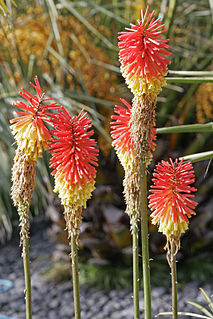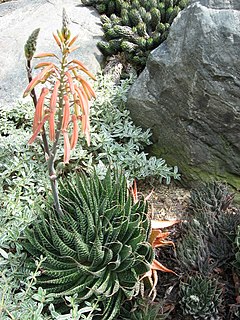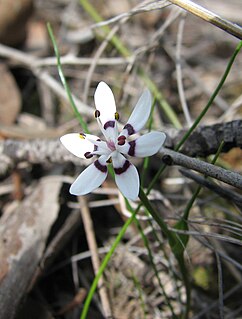
Tulbaghia is a genus of monocotyledonous herbaceous perennial bulbs native to Africa, belonging to the Amaryllis family. It is one of only two known genera in the society garlic tribe within the onion subfamily. The genus was named for Ryk Tulbagh (1699–1771), one time governor of The Cape of Good Hope.

Kniphofia, also called tritoma, red hot poker, torch lily, knofflers or poker plant, is a genus of perennial flowering plants in the family Asphodelaceae, first described as a genus in 1794. It is native to Africa.

Crocosmia (montbretia) is a small genus of flowering plants in the iris family, Iridaceae. It is native to the grasslands of southern and eastern Africa, ranging from South Africa to Sudan. One species is endemic to Madagascar.

Aristaloe is a genus of evergreen flowering perennial plant in the family Asphodelaceae from Southern Africa. Its sole species is Aristaloe aristata, known as guinea-fowl aloe or lace aloe.

Clutia is a plant genus of the family Peraceae. It is native to sub-Saharan Africa and to the Arabian Peninsula.

Aloidendron barberae, formerly Aloe barberae, also known as the tree aloe, is a species of succulent plant in the genus Aloidendron. It is native to South Africa northwards to Mozambique. In its native climes this slow-growing tree can reach up to 18 m (54 ft) high and 0.9 m (3 ft) in stem diameter. Aloidendron barberae is Africa's largest aloe-like plant. The tree aloe is often used as an ornamental plant. Its tubular flowers are rose pink (green-tipped); it flowers in winter and in its natural environment is pollinated by sunbirds.

Trachyandra is a genus of plant in the family Asphodelaceae, subfamily Asphodeloideae, first described as a genus in 1843. It is native to eastern and southern Africa, as well as to Yemen and Madagascar. Many of the species are endemic to South Africa.
- Trachyandra acocksiiOberm. - Cape Province in South Africa
- Trachyandra adamsonii(Compton) Oberm. - Cape Province, Namibia
- Trachyandra affinisKunth - Cape Province, KwaZulu-Natal
- Trachyandra arenicolaJ.C.Manning & Goldblatt - Cape Province
- Trachyandra aridimontanaJ.C.Manning - Cape Province
- Trachyandra arvensis(Schinz) Oberm. - Angola, Zambia, Zimbabwe, Botswana, Namibia
- Trachyandra asperataKunth - South Africa, Lesotho, Swaziland
- Trachyandra brachypoda(Baker) Oberm. - Cape Province
- Trachyandra bulbinifolia(Dinter) Oberm. - Cape Province, Namibia
- Trachyandra burkei(Baker) Oberm. - Botswana, Limpopo, Free State, Cape Province
- Trachyandra capillata(Poelln.) Oberm. - KwaZulu-Natal
- Trachyandra chlamydophylla(Baker) Oberm. - Cape Province
- Trachyandra ciliata(L.f.) Kunth - Cape Province, Namibia
- Trachyandra dissectaOberm. - Cape Province
- Trachyandra divaricata(Jacq.) Kunth - Cape Province; naturalized in Australia
- Trachyandra ensifolia (Sölch) Roessler - Namibia
- Trachyandra erythrorrhiza(Conrath) Oberm. - Gauteng
- Trachyandra esterhuysenaeOberm. - Cape Province
- Trachyandra falcata(L.f.) Kunth - Cape Province, Namibia
- Trachyandra filiformis(Aiton) Oberm. - Cape Province
- Trachyandra flexifolia(L.f.) Kunth - Cape Province
- Trachyandra gerrardii(Baker) Oberm. - Swaziland, South Africa
- Trachyandra giffenii(F.M.Leight.) Oberm. - Cape Province
- Trachyandra glandulosa(Dinter) Oberm. - Namibia
- Trachyandra gracilentaOberm. - Cape Province
- Trachyandra hantamensisBoatwr. & J.C.Manning - Cape Province
- Trachyandra hirsuta(Thunb.) Kunth - Cape Province
- Trachyandra hirsutiflora(Adamson) Oberm. - Cape Province
- Trachyandra hispida(L.) Kunth - Cape Province
- Trachyandra involucrata(Baker) Oberm. - Cape Province
- Trachyandra jacquiniana(Schult. & Schult.f.) Oberm. - Cape Province
- Trachyandra kamiesbergensisBoatwr. & J.C.Manning - Cape Province
- Trachyandra karrooicaOberm. - Cape Province, Namibia
- Trachyandra lanata(Dinter) Oberm. - Namibia
- Trachyandra laxa(N.E.Br.) Oberm. - South Africa, Namibia, Botswana
- Trachyandra malosana(Baker) Oberm. - Malawi to Zimbabwe
- Trachyandra mandrarensis(H.Perrier) Marais & Reilly - Madagascar
- Trachyandra margaretaeOberm. - Mpumalanga, KwaZulu-Natal
- Trachyandra montanaJ.C.Manning & Goldblatt - Cape Province
- Trachyandra muricata(L.f.) Kunth - Cape Province, Namibia
- Trachyandra oligotricha(Baker) Oberm. - Cape Province
- Trachyandra paniculataOberm. - Cape Province
- Trachyandra patensOberm. - Cape Province
- Trachyandra peculiaris(Dinter) Oberm. - Namibia
- Trachyandra proliferaP.L.Perry - Cape Province
- Trachyandra pyrenicarpa(Welw. ex Baker) Oberm. Huíla Province in Angola
- Trachyandra revoluta(L.) Kunth - Cape Province, Namibia
- Trachyandra sabulosa(Adamson) Oberm. - Cape Province
- Trachyandra saltii(Baker) Oberm. - eastern + southern Africa from Ethiopia to Cape Province; Yemen
- Trachyandra sanguinorhizaBoatwr. & J.C.Manning - Cape Province
- Trachyandra scabra(L.f.) Kunth - Cape Province
- Trachyandra smallianaHilliard & B.L.Burtt - Cape Province, KwaZulu-Natal
- Trachyandra tabularis(Baker) Oberm. - Cape Province
- Trachyandra thyrsoidea(Baker) Oberm. - Cape Province
- Trachyandra tortilis(Baker) Oberm. - Cape Province
- Trachyandra triquetraThulin - Somalia
- Trachyandra zebrina(Schltr. ex Poelln.) Oberm. - Cape Province

Dierama is a genus of flowering plants in the iris family, Iridaceae. Common names include hairbells, Angel's Fishing Rod, fairybells, and wandflowers in English and grasklokkies in Afrikaans. They are native to Africa, with most occurring in the southern regions of the continent. The center of diversity is the province of KwaZulu-Natal in eastern South Africa.

Wurmbea is a genus of perennial herbs in the family Colchicaceae, native to Africa and Australia. There are about 50 species, with about half endemic to each continent.
Prosphytochloa is a genus of African plants in the grass family. The only known species is Prosphytochloa prehensilis, native to Eastern Cape Province, KwaZulu-Natal, Swaziland, Mpumalanga, and Limpopo.
Tenrhynea is a genus of Southern African plants in the pussy's-toes tribe within the sunflower family.
Harpochloa is a genus of African plants in the grass family, common name caterpillar grass.
- Harpochloa falx(L.f.) Kuntze - Eastern Cape, KwaZulu-Natal, Lesotho, Gauteng, Swaziland, Free State, Mpumalanga
- Harpochloa pseudoharpechloa(Chiov.) Clayton - Zaïre, Zambia, Angola

Euclea racemosa is a small to medium-sized evergreen tree that is indigenous to the Indian Ocean coast of Africa from Egypt to South Africa, as well as in Comoros, Oman and Yemen.

Eucomis bicolor, the variegated pineapple lily or just pineapple lily, is a bulbous species of flowering plant in the family Asparagaceae, subfamily Scilloideae, native to Southern Africa. The pale green, purple-margined flowers are arranged in a spike (raceme), topped by a "head" of green leaflike bracts. It is cultivated as an ornamental bulbous plant, although its flowers have an unpleasant smell, attractive to the main pollinators, flies.

Eucomis pallidiflora is a bulbous species of flowering plant in the family Asparagaceae, subfamily Scilloideae, native to southern Africa. The white to green flowers appear in summer and are arranged in a spike (raceme), topped by a "head" of green leaflike bracts. Some forms reach almost 2 m when in flower. The species is cultivated as an ornamental plant, although it is not hardy in areas where severe frosts occur.

Empodium is a genus of flowering plants in the family Hypoxidaceae, first described in 1866. It grows from a small corm which produces lance-shaped or pleated and sometimes hairy, star-shaped flowers and leaves with 10–30 centimetres (4–12 in) long in Autumn season. The genus is native to winter-rainfall areas in South Africa, Swaziland, Lesotho, and Namibia.
- Empodium elongatum(Nel) B.L.Burtt - Lesotho, Swaziland, Lesotho
- Empodium flexile(Nel) M.F.Thomps. ex Snijman - Cape Province
- Empodium gloriosum(Nel) B.L.Burtt - Cape Province
- Empodium monophyllum(Nel) B.L.Burtt - KwaZulu-Natal, Swaziland
- Empodium namaquensis(Baker) M.F.Thomps. - Cape Province
- Empodium plicatum(Thunb.) Garside - Cape Province
- Empodium veratrifolium(Willd.) M.F.Thomps. - Cape Province

Scadoxus membranaceus is a bulbous plant from South Africa. The smallest of the species of Scadoxus, it is sometimes cultivated as an ornamental plant where a minimum temperature of 5 °C (41 °F) can be maintained.
Saniella is a flowering plant genus in the family Hypoxidaceae, native to South Africa and Lesotho. Two species are recognised:

Craterocapsa is a genus of plants in the family Campanulaceae. It contains 5 known species, all native to southern Africa.
Acrotome is a genus of plants in the Lamiaceae, first described in 1838. The genus is native to the southern part of Africa.






















